Application of a Finite-Discrete Element Method Code for Modelling Rock Spalling in Tunnels: The Case of the Lyon-Turin Base Tunnel
Abstract
1. Introduction
2. Materials and Methods
2.1. Fundamentals of Brittle Failure Numerical Modelling
2.2. Description of the Case Study
2.3. Construction of the Numerical Model
3. Results
4. Discussion
- the Damage Initiation-Spalling Limit (DISL) approach [16], which is a composite envelope describing different rock behaviour depending on the level of confinement,
- the Cohesion Weakening and Frictional Strengthening (CWFS) approach [12], which assumes that cohesive and frictional resistances are not mobilised at the same time and
- the FDEM method, adopting the Y-Geo code [20].
5. Conclusions
Supplementary Materials
Author Contributions
Funding
Institutional Review Board Statement
Informed Consent Statement
Data Availability Statement
Conflicts of Interest
References
- Martin, C.D.; Kaiser, P.K.; Christiansson, R. Stress, instability and design of underground excavations. Int. J. Rock Mech. Min. Sci. 2003, 40, 1027–1047. [Google Scholar] [CrossRef]
- Zheng, Z.; Kemeny, J.; Cook, N.G.W. Analysis of borehole breakouts. J. Geophys. Res. 1989, 94, 7171–7182. [Google Scholar] [CrossRef]
- Martin, C.D.; Read, R.S.; Martino, J.B. Observation of brittle failure around a circular test tunnel. Int. J. Rock Mech. Min. Sci. 1997, 34, 1065–1073. [Google Scholar] [CrossRef]
- Ortlepp, W.D. The behaviour of tunnels at great depth under large static and dynamic pressures. Tunn. Undergr. Space Technol. 2001, 16, 41–48. [Google Scholar] [CrossRef]
- Ortlepp, W.D. Rock Fracture and Rockbursts—An Illustrative Study; Monograph Series M9, South African Institute of Mining and Metallurgy: Johannesburg, South Africa, 1997. [Google Scholar]
- Martin, C.D.; Kaiser, P.K.; McCreath, D.R. Hoek–Brown parameters for predicting the depth of brittle failure around tunnels. Can. Geotech. J. 1999, 36, 136–151. [Google Scholar] [CrossRef]
- Eberhardt, E.; Stead, D.; Stimpson, B.; Read, R.S. Identifying crack initiation and propagation thresholds in brittle rock. Can. Geotech. J. 1998, 35, 222–233. [Google Scholar] [CrossRef]
- Diederichs, M. Damage initiation and propagation in hard rock during tunnelling and the influence of near-face stress rotation. Int. J. Rock Mech. Min. Sci. 2004, 41, 785–812. [Google Scholar] [CrossRef]
- Hoek, E.; Kaiser, P.K.; Bawden, W.F. Support of Underground Excavations in Hard Rock, 1st ed.; CRC Press: London, UK, 2000; pp. 1–228. [Google Scholar]
- Ortlepp, W.D.; Stacey, T.R. Rockburst mechanisms in tunnels and shafts. Tunn. Undergr. Space Technol. 1994, 9, 59–65. [Google Scholar] [CrossRef]
- Lee, S.M.; Park, B.S.; Lee, S.W. Analysis of rockbursts that have occurred in a waterway tunnel in Korea. Int. J. Rock Mech. Min. Sci. 2004, 41, 911–916. [Google Scholar] [CrossRef]
- Hajiabdolmajid, V.; Kaiser, P.; Martin, C.D. Modelling brittle failure of rock. Int. J. Rock Mech. 2002, 39, 731–741. [Google Scholar] [CrossRef]
- Vlachopoulos, N.; Vazaios, I. The Numerical Simulation of Hard Rocks for Tunnelling Purposes at Great Depths: A Comparison between the Hybrid FDEM Method and Continuous Techniques. Adv. Civ. Eng. 2018, 2018, 3868716. [Google Scholar] [CrossRef]
- Martin, C.D.; Chandler, N.A. The progressive fracture of Lac du Bonnet granite. Int. J. Rock Mech. Min. Sci. Geomech. Abstr. 1994, 31, 643–659. [Google Scholar] [CrossRef]
- Hajiabdolmajid, V.R. Mobilization of Strength in Brittle Failure of Rock. Ph.D. Thesis, Department of Mining Engineering, Queen’s University, Kingston, ON, Canada, 2001. [Google Scholar]
- Diederichs, M. Mechanistic interpretation and practical application of damage and spalling prediction criteria for deep tunneling. Can. Geotech. J. 2007, 44, 1082–1116. [Google Scholar] [CrossRef]
- Hamdi, P.; Stead, D.; Elmo, D. A Review of the Application of Numerical Modelling in the Prediction of Depth of Spalling Damage around Underground Openings. In Proceedings of the 51st U.S. Rock Mechanics/Geomechanics Symposium, San Francisco, CA, USA, 25–28 June 2017. [Google Scholar]
- Martin, D. The impact of brittle behaviour of rocks on tunnel excavation design. In Rock Engineering and Rock Mechanics: Structures in and on Rock Masses; Alejano, R., Perucho, Á., Olalla, C., Jiménez, R., Eds.; CRC Press: London, UK, 2014; pp. 51–62. [Google Scholar]
- Cundall, P.A.; Hart, R.D. Numerical modelling of discontinua. Eng. Comput. 1992, 9, 101–113. [Google Scholar] [CrossRef]
- Mahabadi, O.K.; Lisjak, A.; Munjiza, A.; Grasselli, G. Y-Geo: New Combined Finite-Discrete Element Numerical Code for Geomechanical Applications. Int. J. Geomech. 2012, 12, 676–688. [Google Scholar] [CrossRef]
- Lan, H.; Martin, C.D.; Hu, B. Effect of heterogeneity of brittle rock on micromechanical extensile behavior during compression loading. J. Geophys. Res. 2010, 115, B01202. [Google Scholar] [CrossRef]
- Insana, A.; Elmo, D.; Barla, M. Multi scale numerical modelling related to hydrofracking for deep geothermal energy exploitation. Procedia Eng. 2016, 158, 314–319. [Google Scholar] [CrossRef]
- Wang, Z.; Böhlke, T.; Zhang, W.; Gu, D. A novel random angular bend (RAB) algorithm and DEM modeling of thermal cracking responses of sandstone. Geomech. Energy Environ. 2022, 32, 100335. [Google Scholar] [CrossRef]
- Elmo, D.; Stead, D. An Integrated Numerical Modelling–Discrete Fracture Network Approach Applied to the Characterisation of Rock Mass Strength of Naturally Fractured Pillars. Rock Mech. Rock Eng. 2010, 43, 3–19. [Google Scholar] [CrossRef]
- Munjiza, A.; Owen, D.R.J.; Bicanic, N. A combined finite-discrete element method in transient dynamics of fracturing solids. Eng. Comput. 1995, 12, 145–174. [Google Scholar] [CrossRef]
- Mahabadi, O.K.; Lisjak, A.; He, L.; Tatone, B.S.A.; Kaifosh, P.; Grasselli, G. Development of a new fully-parallel finite-discrete element code: Irazu. In Proceedings of the 50th U.S. Rock Mechanics/Geomechanics Symposium 2016, Houston, TX, USA, 26–29 June 2016; Volume 4, pp. 2695–2703. [Google Scholar]
- Lisjak, A.; Mahabadi, O.K.; He, L.; Tatone, B.S.A.; Kaifosh, P.; Haque, S.A.; Grasselli, G. Acceleration of a 2D/3D finite-discrete element code for geomechanical simulations using General Purpose GPU computing. Comput. Geotech. 2018, 100, 84–96. [Google Scholar] [CrossRef]
- Geomechanica Inc. Irazu 2D Geomechanical Simulation Software, V. 6.1.; Theory Manual; Geomechanica Inc.: Toronto, ON, Canada, 2023. [Google Scholar]
- Mahabadi, O.K.; Grasselli, G.; Munjiza, A. Numerical modelling of a Brazilian Disc test of layered rocks using the combined finite-discrete element method. In Proceedings of the 3rd Canada-US (CANUS) Rock Mechanics Symposium (RockEng09), Toronto, ON, Canada, 9–15 May 2009. [Google Scholar]
- Mahabadi, O.K.; Lisjak, A.; Grasselli, G.; Lukas, T.; Munjiza, A. Numerical modelling of a triaxial test of homogeneous rocks using the combined finite-discrete element method. In Proceedings of the European Rock Mechanics Symposium EUROCK 2010, EPFL, Lausanne, Switzerland, 15–18 June 2010. [Google Scholar]
- Deng, P.; Liu, Q.; Huang, X.; Pan, Y.; Wu, J. FDEM numerical modelling of failure mechanism of anisotropic rock masses around deep tunnels. Comput. Geotech. 2022, 142, 104535. [Google Scholar] [CrossRef]
- Lisjak, A.; Grasselli, G. A review of discrete modeling techniques for fracturing processes in discontinuous rock masses. J. Rock Mech. Geotech. Eng. 2014, 6, 301–314. [Google Scholar] [CrossRef]
- Senemaud, J.; Serrano, B.; Salot, C.; Parisi, M.E.; Brino, L. Contribution of twenty years of exploratory work in the complex carboniferous formation of the montcenis base tunnel. In Proceedings of the ITA-AITES World Tunnel Congress 2023 (WTC 2023), Athens, Greece, 12–18 May 2023. [Google Scholar]
- Barla, M.; Antolini, F. Combined Finite-Discrete numerical modeling of rock spalling in tunnels. In Proceedings of the 14th International Conference of the International Association for Computer Methods and Advances in Geomechanics, Kyoto, Japan, 21–24 September 2014. [Google Scholar]
- Parisi, M.E.; Farinetti, A.; Brino, L. Measurement of massif temperatures through the Maddalena exploration tunnel. In Proceedings of the ITA-AITES World Tunnel Congress 2018 (WTC 2018), Dubai, United Arab Emirates, 21–26 April 2018. [Google Scholar]
- Barla, G.; Barla, M. Continuum and discontinuum modelling in tunnel engineering. Rud. Geol. Naft. Zb. 2000, 12, 45–57. [Google Scholar]

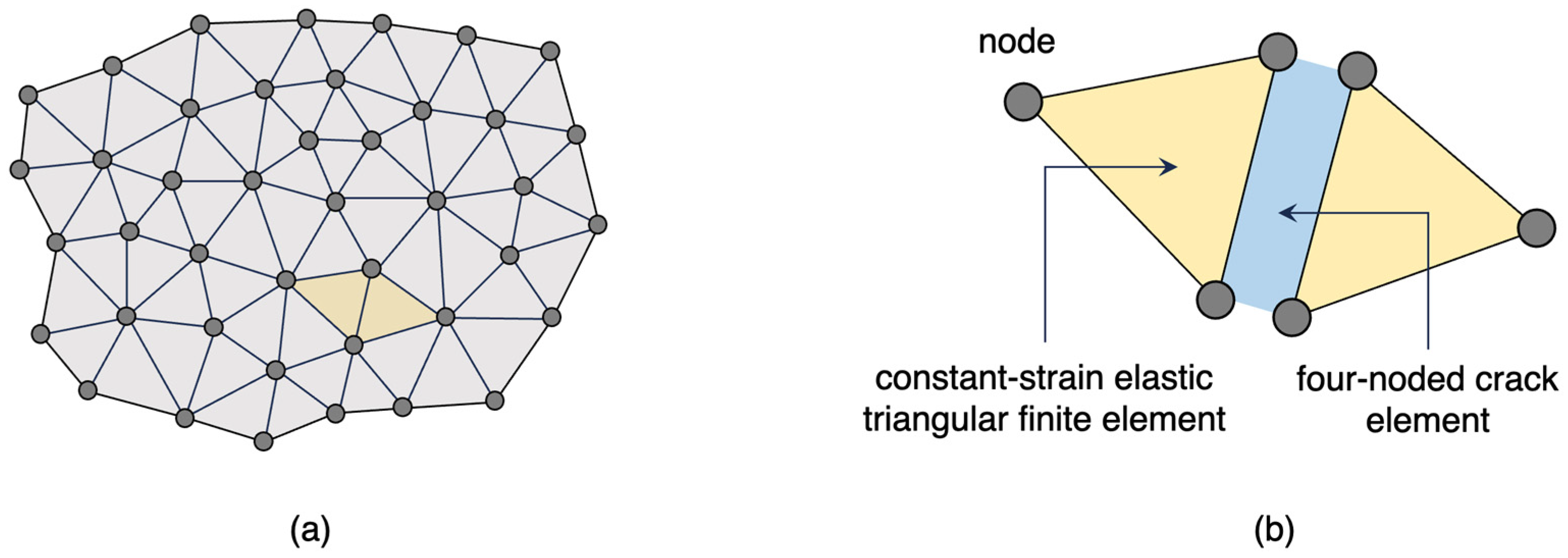
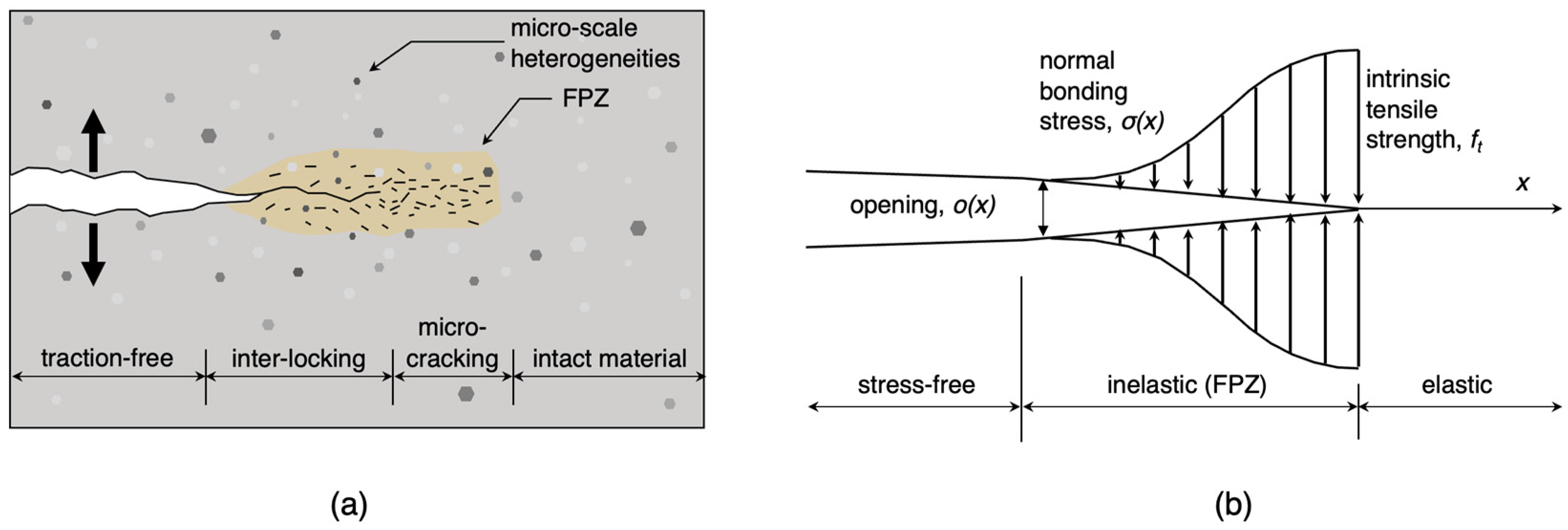




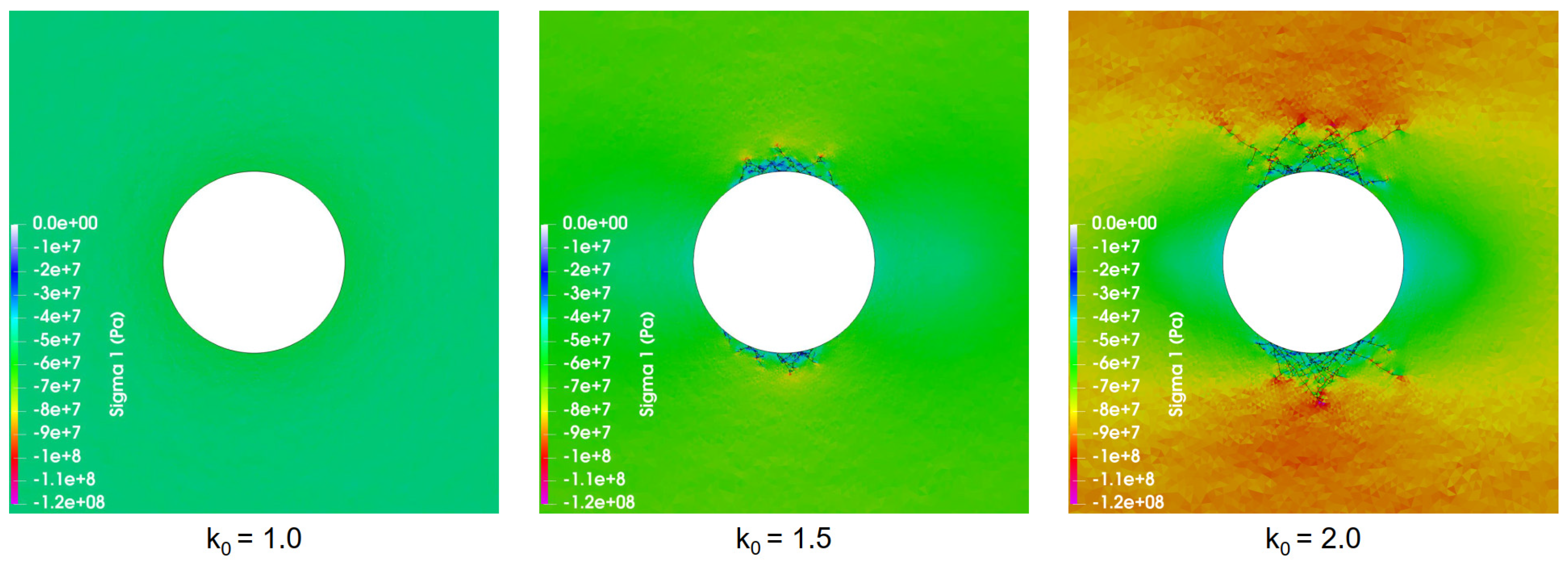


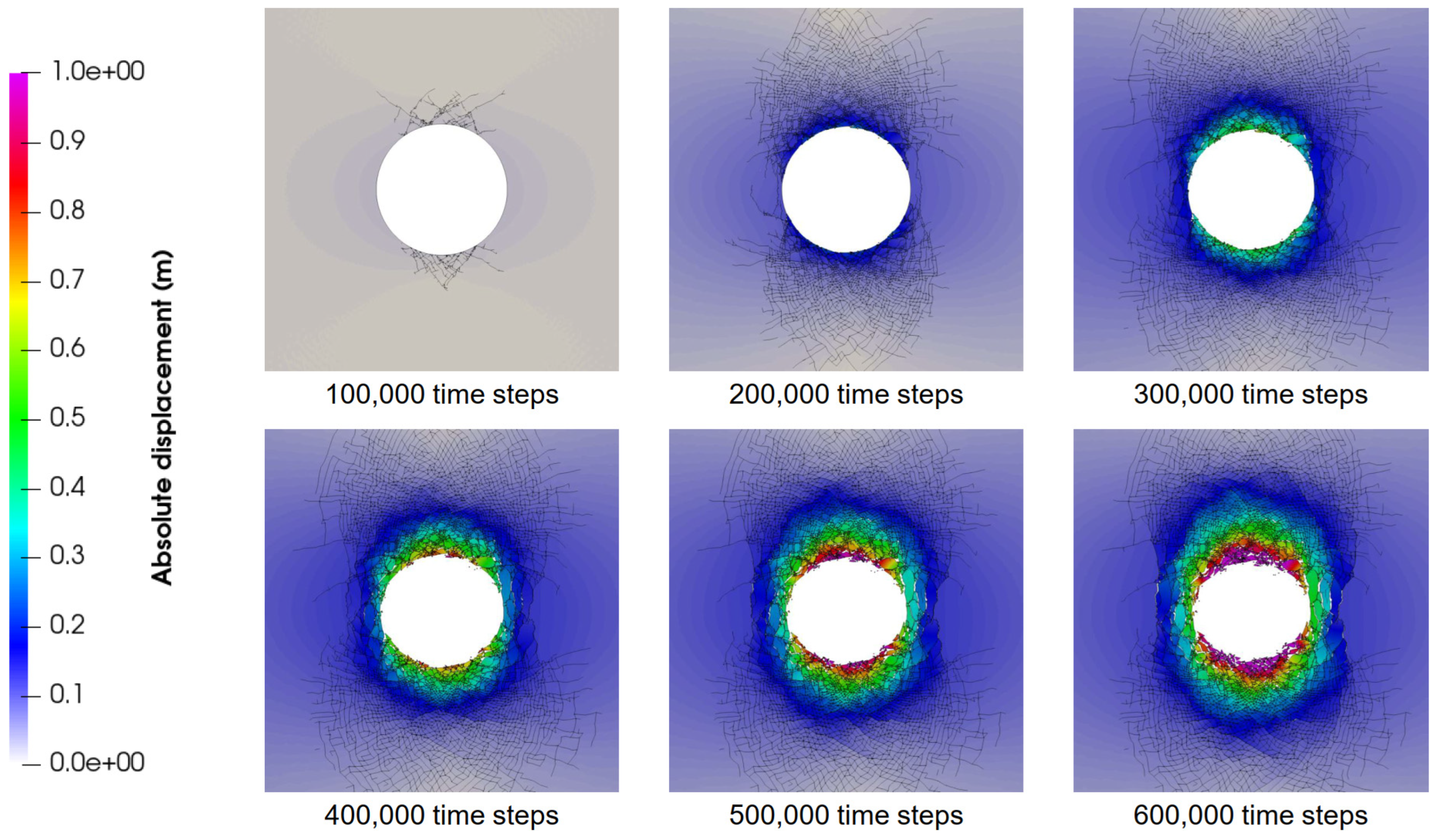
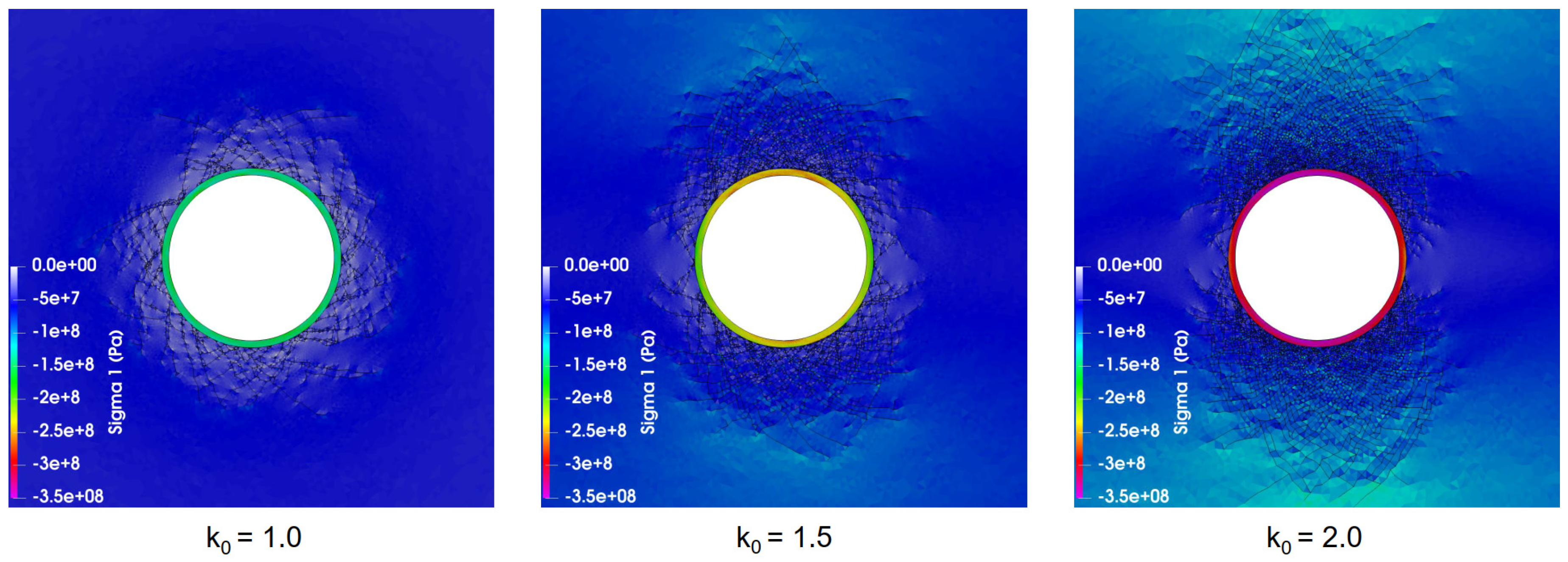

| Properties | Value | Properties | Value |
|---|---|---|---|
| E (GPa) | 35 | sp (-) | 0.0558 |
| v (-) | 0.25 | sr (-) | 0.0054 |
| GSI (-) | 90 | cp (MPa) | 26.5 |
| σti (MPa) | 10 | Φp (°) | 15.8 |
| σci (MPa) | 144 | cr (MPa) | 0.6 |
| mp (-) | 0.39 | Φr (°) | 55.0 |
| mr (-) | 8 | γ (kg/m3) | 2500 |
| Parameter | Value or Type |
|---|---|
| Friction coefficient, fr | 0.7 |
| Type of fracture model | Isotropic |
| Cohesion, c | 23 MPa |
| Tensile strength, ft | 10 MPa |
| Mode I fracture energy, GfI | 32.5 N/m |
| Mode II fracture energy, GfII | 650 N/m |
| Fracture penalty, pf | 17.5 GPa |
| Normal penalty, pn | 35 GPa·m |
| Tangential penalty, pt | 8.5 GPa/m |
| Case | Stress Ratio k0 = σh/σv | σ1 = σh = σxx (MPa) | σ3 = σv = σyy (MPa) |
|---|---|---|---|
| A | 1.0 | 66.4 | 66.4 |
| B | 1.5 | 99.6 | 66.4 |
| C | 2.0 | 132.8 | 66.4 |
Disclaimer/Publisher’s Note: The statements, opinions and data contained in all publications are solely those of the individual author(s) and contributor(s) and not of MDPI and/or the editor(s). MDPI and/or the editor(s) disclaim responsibility for any injury to people or property resulting from any ideas, methods, instructions or products referred to in the content. |
© 2024 by the authors. Licensee MDPI, Basel, Switzerland. This article is an open access article distributed under the terms and conditions of the Creative Commons Attribution (CC BY) license (https://creativecommons.org/licenses/by/4.0/).
Share and Cite
Martinelli, D.; Insana, A. Application of a Finite-Discrete Element Method Code for Modelling Rock Spalling in Tunnels: The Case of the Lyon-Turin Base Tunnel. Appl. Sci. 2024, 14, 591. https://doi.org/10.3390/app14020591
Martinelli D, Insana A. Application of a Finite-Discrete Element Method Code for Modelling Rock Spalling in Tunnels: The Case of the Lyon-Turin Base Tunnel. Applied Sciences. 2024; 14(2):591. https://doi.org/10.3390/app14020591
Chicago/Turabian StyleMartinelli, Daniele, and Alessandra Insana. 2024. "Application of a Finite-Discrete Element Method Code for Modelling Rock Spalling in Tunnels: The Case of the Lyon-Turin Base Tunnel" Applied Sciences 14, no. 2: 591. https://doi.org/10.3390/app14020591
APA StyleMartinelli, D., & Insana, A. (2024). Application of a Finite-Discrete Element Method Code for Modelling Rock Spalling in Tunnels: The Case of the Lyon-Turin Base Tunnel. Applied Sciences, 14(2), 591. https://doi.org/10.3390/app14020591







